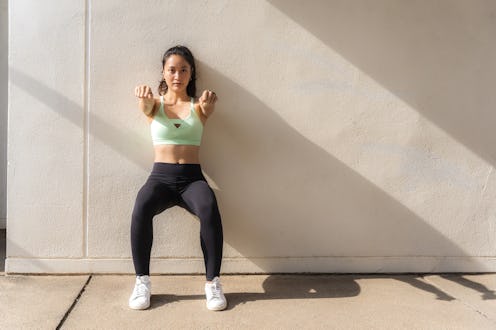Fitness
Here's How Long You Should Hold A Wall Sit
Unfortunately, the answer isn't five seconds.

Wall sits are a classic strength training move that can be done pretty much anywhere. They’re simple, too — all you have to do is sit back against a wall. If you’ve ever dropped into the bodyweight-based lower body move, though, you know that its simplicity does not make it easy. Because it has the power to make mere seconds feel excruciatingly long, Bustle asked fitness experts the all-important question: How long should you hold a wall sit for the best strength-boosting results?
A wall sit, also called a wall squat, is actually one of the toughest bodyweight exercises out there, says Lalitha McSorley, PT, a physical therapist and personal trainer at Brentwood Physiotherapy Calgary. “Wall sits require tremendous core strength as well as leg strength to stay in position,” she tells Bustle. That’s why even experienced athletes think they’re rough, she says.
Like planks, wall sits are an isometric move that puts your muscles under a lot of tension, says Janet Li, a Pilates instructor and owner of RE Pilates. “There’s no way to cheat in this position,” she says. They also call on quite a few muscles at once. As you lower down into the squat, you have to engage your glutes, hamstrings, quads, and abs to hold yourself up, McSorley adds. If you reach your hands forward, your arms and chest get in on the action, too.
They may be hard, but they’re totally worth adding to your workout routine. Not only do wall sits make you stronger, but they’re also a good exercise to do when you’re looking for something low impact, Li tells Bustle. Regular rounds of wall sits will help improve your posture, too. “The wall gives your body feedback to any asymmetry and also tells you where all your body parts should be, like how your head should be stacked right on top of your body and not edged forward as seen in many tech necks,” says Li. Read on for everything to know about wall sits, including how long you should be holding the pose.
How To Do A Wall Sit
Here, Li explains how to do a wall sit with good form so you get the most out of the move.
- Stand with your back leaning against a wall.
- Walk your feet out so they’re a foot or two away from the wall.
- Slide down the wall until your knees are bent 90 degrees.
- Keep your back straight and tailbone lengthened towards the floor.
- Ensure your toes and knees are pointing forward.
- Engage your abs.
- Press your back muscles up against the wall.
- Reach your arms out in front of you or clasp your hands at your chest.
- Hold.
- To stand, push down into your heels and slide back up the wall.
How Long To Hold A Wall Sit
Once you get in position, aim to hold the wall sit for about 30 seconds, adjusting as necessary. “Holding a wall sit for an extended period of time can be incredibly beneficial, but the length that you should hold it depends on your fitness level and goals,” McSorley says. “You can take breaks as needed if the exercise becomes too difficult.”
Holding the position for 30 to 45 seconds is a good place to start, but if 30 seconds feels like a breeze, try adding 30-second intervals each time you do the exercise, Li says. Once you become a pro at that, you can hold a wall sit as long as you want.
“For runners, skiers, and other endurance sports athletes, try to hold as long as possible,” Li says, noting it can help with your endurance training. Like planks, it’s one of those moves you can challenge yourself to maintain for long periods of time.
How To Modify A Wall Sit
To make this move a little easier, slide up the wall until your knees are no longer bent 90 degrees. That’ll take some of the pressure off your legs and core while still giving you a good workout. Feel free to stay here for however long it takes until you’re ready to progress.
If you want to kick your wall sit game up a notch, hold it for a minute or more with knees bent 90 degrees and your arms out in front of you. For an even bigger challenge, ask a friend to place a weight on your thighs while you’re holding the squat, McSorley says. The extra resistance will make this already-tough move even tougher.
Common Mistakes To Avoid
In order to avoid injury and reap the full benefits of the exercise, McSorley stresses the importance of doing a wall sit in proper form. For starters, she says to avoid leaning back against soft drywall or wood paneling, as it probably won’t be stable enough.
You should also check your form throughout, especially as you start to get tired. Make sure your lower back stays supported and your knees parallel instead of caved in, Li says. And, most importantly, remember to breathe. “A lot of beginners tend to hold their breath during this exercise,” McSorley adds. So inhale, exhale, and think about what you’re going to watch on Netflix later instead of how much your legs are burning.
Studies referenced:
Cho, M. (2013). The effects of modified wall squat exercises on average adults' deep abdominal muscle thickness and lumbar stability. J Phys Ther Sci. doi: 10.1589/jpts.25.689.
Lee, JH. (2022). Differences in the muscle activities of the quadriceps femoris and hamstrings while performing various squat exercises. BMC Sports Sci Med Rehabil. doi: 10.1186/s13102-022-00404-6.
Lee, Y. (2015). The influence of unstable modified wall squat exercises on the posture of female university students. J Phys Ther Sci. doi: 10.1589/jpts.27.2477.
Sources:
Lalitha McSorley, PT, physical therapist, personal trainer at Brentwood Physiotherapy Calgary
Janet Li, Pilates instructor, owner of RE Pilates